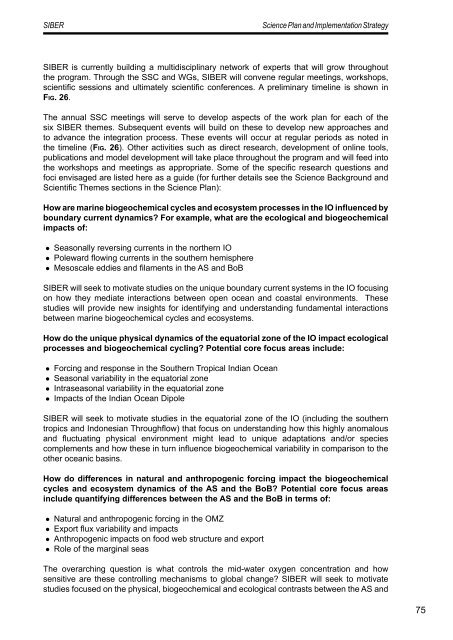SIBER SPIS sept 2011.pdf - IMBER
SIBER SPIS sept 2011.pdf - IMBER
SIBER SPIS sept 2011.pdf - IMBER
Create successful ePaper yourself
Turn your PDF publications into a flip-book with our unique Google optimized e-Paper software.
<strong>SIBER</strong><br />
Science Plan and Implementation Strategy<br />
<strong>SIBER</strong> is currently building a multidisciplinary network of experts that will grow throughout<br />
the program. Through the SSC and WGs, <strong>SIBER</strong> will convene regular meetings, workshops,<br />
scientific sessions and ultimately scientific conferences. A preliminary timeline is shown in<br />
Fig. 26.<br />
The annual SSC meetings will serve to develop aspects of the work plan for each of the<br />
six <strong>SIBER</strong> themes. Subsequent events will build on these to develop new approaches and<br />
to advance the integration process. These events will occur at regular periods as noted in<br />
the timeline (Fig. 26). Other activities such as direct research, development of online tools,<br />
publications and model development will take place throughout the program and will feed into<br />
the workshops and meetings as appropriate. Some of the specific research questions and<br />
foci envisaged are listed here as a guide (for further details see the Science Background and<br />
Scientific Themes sections in the Science Plan):<br />
How are marine biogeochemical cycles and ecosystem processes in the IO influenced by<br />
boundary current dynamics For example, what are the ecological and biogeochemical<br />
impacts of:<br />
●● Seasonally reversing currents in the northern IO<br />
●● Poleward flowing currents in the southern hemisphere<br />
●● Mesoscale eddies and filaments in the AS and BoB<br />
<strong>SIBER</strong> will seek to motivate studies on the unique boundary current systems in the IO focusing<br />
on how they mediate interactions between open ocean and coastal environments. These<br />
studies will provide new insights for identifying and understanding fundamental interactions<br />
between marine biogeochemical cycles and ecosystems.<br />
How do the unique physical dynamics of the equatorial zone of the IO impact ecological<br />
processes and biogeochemical cycling Potential core focus areas include:<br />
●● Forcing and response in the Southern Tropical Indian Ocean<br />
●● Seasonal variability in the equatorial zone<br />
●● Intraseasonal variability in the equatorial zone<br />
●● Impacts of the Indian Ocean Dipole<br />
<strong>SIBER</strong> will seek to motivate studies in the equatorial zone of the IO (including the southern<br />
tropics and Indonesian Throughflow) that focus on understanding how this highly anomalous<br />
and fluctuating physical environment might lead to unique adaptations and/or species<br />
complements and how these in turn influence biogeochemical variability in comparison to the<br />
other oceanic basins.<br />
How do differences in natural and anthropogenic forcing impact the biogeochemical<br />
cycles and ecosystem dynamics of the AS and the BoB Potential core focus areas<br />
include quantifying differences between the AS and the BoB in terms of:<br />
●● Natural and anthropogenic forcing in the OMZ<br />
●● Export flux variability and impacts<br />
●● Anthropogenic impacts on food web structure and export<br />
●● Role of the marginal seas<br />
The overarching question is what controls the mid-water oxygen concentration and how<br />
sensitive are these controlling mechanisms to global change <strong>SIBER</strong> will seek to motivate<br />
studies focused on the physical, biogeochemical and ecological contrasts between the AS and<br />
75












